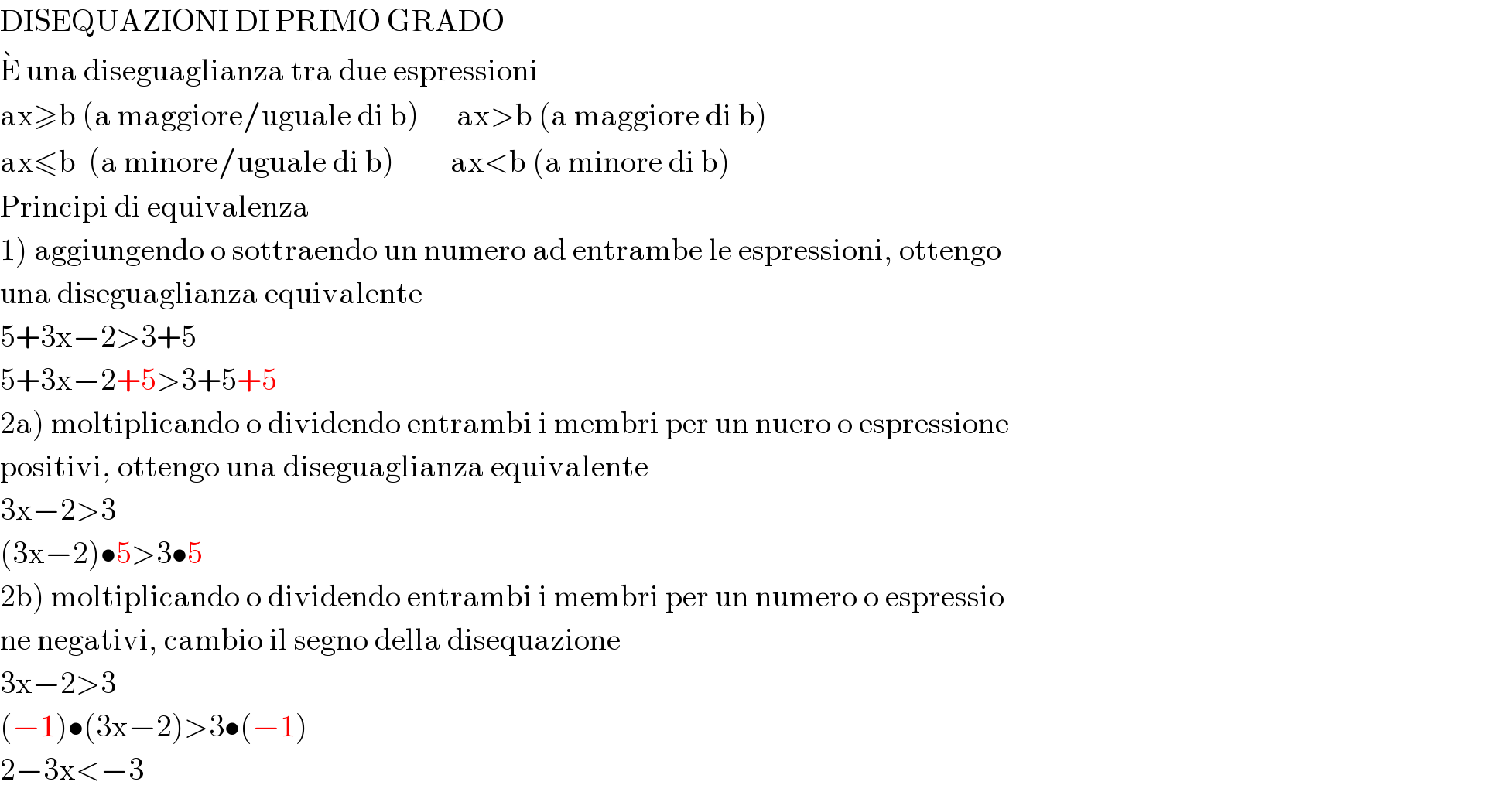Question Number 118372 by Cristina last updated on 17/Oct/20

$$\mathrm{DISEQUAZIONI}\:\mathrm{DI}\:\mathrm{PRIMO}\:\mathrm{GRADO} \\ $$$$\grave {\mathrm{E}}\:\mathrm{una}\:\mathrm{diseguaglianza}\:\mathrm{tra}\:\mathrm{due}\:\mathrm{espressioni} \\ $$$$\mathrm{ax}\geqslant\mathrm{b}\:\left(\mathrm{a}\:\mathrm{maggiore}/\mathrm{uguale}\:\mathrm{di}\:\mathrm{b}\right)\:\:\:\:\:\:\mathrm{ax}>\mathrm{b}\:\left(\mathrm{a}\:\mathrm{maggiore}\:\mathrm{di}\:\mathrm{b}\right) \\ $$$$\mathrm{ax}\leqslant\mathrm{b}\:\:\left(\mathrm{a}\:\mathrm{minore}/\mathrm{uguale}\:\mathrm{di}\:\mathrm{b}\right)\:\:\:\:\:\:\:\:\:\mathrm{ax}<\mathrm{b}\:\left(\mathrm{a}\:\mathrm{minore}\:\mathrm{di}\:\mathrm{b}\right) \\ $$$$\mathrm{Principi}\:\mathrm{di}\:\mathrm{equivalenza} \\ $$$$\left.\mathrm{1}\right)\:\mathrm{aggiungendo}\:\mathrm{o}\:\mathrm{sottraendo}\:\mathrm{un}\:\mathrm{numero}\:\mathrm{ad}\:\mathrm{entrambe}\:\mathrm{le}\:\mathrm{espressioni},\:\mathrm{ottengo} \\ $$$$\mathrm{una}\:\mathrm{diseguaglianza}\:\mathrm{equivalente} \\ $$$$\mathrm{5}+\mathrm{3x}−\mathrm{2}>\mathrm{3}+\mathrm{5} \\ $$$$\mathrm{5}+\mathrm{3x}−\mathrm{2}+\mathrm{5}>\mathrm{3}+\mathrm{5}+\mathrm{5} \\ $$$$\left.\mathrm{2a}\right)\:\mathrm{moltiplicando}\:\mathrm{o}\:\mathrm{dividendo}\:\mathrm{entrambi}\:\mathrm{i}\:\mathrm{membri}\:\mathrm{per}\:\mathrm{un}\:\mathrm{nuero}\:\mathrm{o}\:\mathrm{espressione} \\ $$$$\mathrm{positivi},\:\mathrm{ottengo}\:\mathrm{una}\:\mathrm{diseguaglianza}\:\mathrm{equivalente} \\ $$$$\mathrm{3x}−\mathrm{2}>\mathrm{3} \\ $$$$\left(\mathrm{3x}−\mathrm{2}\right)\bullet\mathrm{5}>\mathrm{3}\bullet\mathrm{5} \\ $$$$\left.\mathrm{2b}\right)\:\mathrm{moltiplicando}\:\mathrm{o}\:\mathrm{dividendo}\:\mathrm{entrambi}\:\mathrm{i}\:\mathrm{membri}\:\mathrm{per}\:\mathrm{un}\:\mathrm{numero}\:\mathrm{o}\:\mathrm{espressio} \\ $$$$\mathrm{ne}\:\mathrm{negativi},\:\mathrm{cambio}\:\mathrm{il}\:\mathrm{segno}\:\mathrm{della}\:\mathrm{disequazione} \\ $$$$\mathrm{3x}−\mathrm{2}>\mathrm{3} \\ $$$$\left(−\mathrm{1}\right)\bullet\left(\mathrm{3x}−\mathrm{2}\right)>\mathrm{3}\bullet\left(−\mathrm{1}\right) \\ $$$$\mathrm{2}−\mathrm{3x}<−\mathrm{3} \\ $$
